GUIDELINES & STRATEGIES – Original Article:
Active Ageing Singapore: The Conceptualization of Age-Supportive Built Environments for Physical Activities in a Liveable High-Density City
Christoph Szubski *
*Author’s contact: https://www.linkedin.com/in/chrisszubski/
Suggested citation for this article:
Szubski C: Active Ageing Singapore: The conceptualization of age-supportive built environments for physical activities in a liveable high-density city. Sportify Cities – Guidelines and Strategies. Sportify Cities, 2017. Available at: https://sportifycities.com/active-ageing-singapore/
Download PDF Version 
Summary
In an era of rising ageing population levels and urban densification across the developed world, the aspect of providing older residents with adequate built environments for physical activities will become one of the key features of public health policies in large, high-density cities. Given Singapore’s rapidly ageing society and its densely populated urban districts, this article briefly presents the city’s key active ageing-supportive urban features that could serve as a basis for further expansion and maturation of this vital public good in Singapore and beyond this tropical South-East Asian city. It subsequently introduces a novel conceptual framework outlining six key physical determinants for the city’s potential Active Ageing Singapore formation process and enhanced city liveability by merging the aspects of active lifestyle, urban planning, ageing populations, public policy, environment and city marketing.
1. Ageing City Populations
Singapore regularly leads in popularised city rankings assessing business-friendliness, global finance services, socio-political stability, government efficiency, personal safety, technology readiness, infrastructure, education and global appeal1,2,3,4. Yet in the coming decades this city-state will also top the worldwide city rankings with regard to ageing populations. While in 2008 merely 12.8% of Singapore residents were aged 60 years and above, this proportion has skyrocketed within a few years alone, reaching more than 18% in 20165. And by 2050 Singapore is expected to become a geriatric society – along with Japan, Germany, South Korea and Hong Kong (see Chart 1).
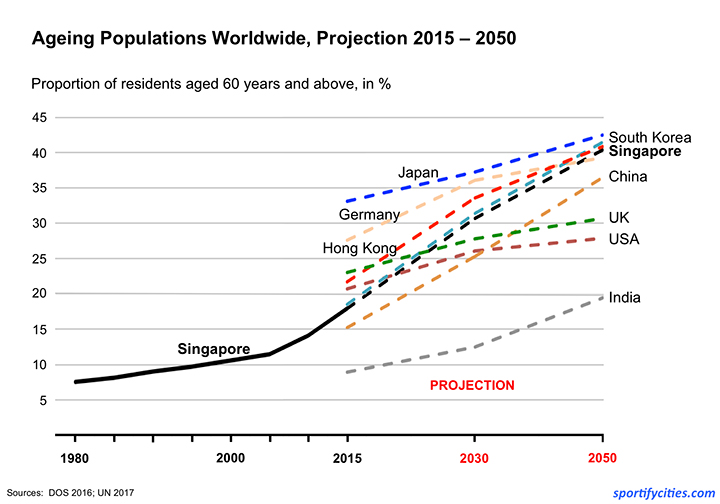
Chart 1. Proportion of residents aged 60 years and above in Singapore (1980 – 2050) and in other ageing societies worldwide (2015 – 2050)5,6.
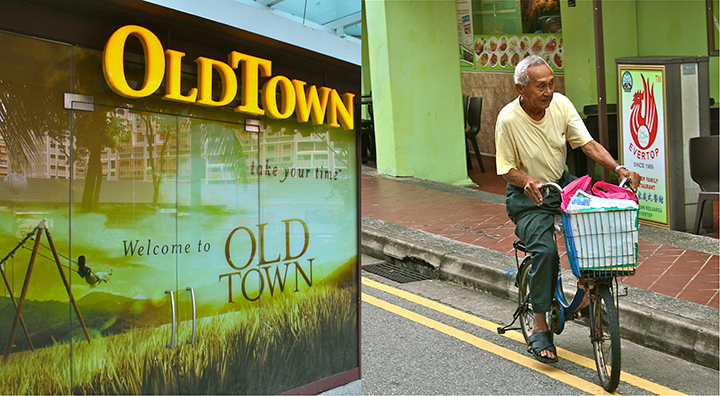
Singapore will inevitably become a geriatric society by 2030
Apart from its inevitable trend towards an ageing society, most residential districts of this South-East Asian city also displays characteristics of high-density cities7. As the city’s population is projected to grow from currently 5.5 million to nearly 7 million by 20308, the districts will continue to become more densely populated. Yet despite this ongoing urban densification process, a vibrant active lifestyle trend has been able to emerge across the city over the past decades. The rapidly changing attitudes among Singaporeans towards living a healthier life have resulted in greater physical activity participation levels, with 26% of Singapore residents now being engaged in physical and sporting activities at least three times a week – compared to merely 8% in 19929,10. In addition, the number of recreational running competitions has surged to 126 in 201611, implying increased societal interest in physical health and fitness. Most notably, around 40% of the city’s elderly – aged 60 years and beyond – engage frequently in physical activity10.
This popularisation of physical activity participation across all generations can largely be attributed to a range of public health initiatives, promotions and courses that has been developed and organized as part of the National Healthy Lifestyle Programme since 199212. And when asked local seniors about the reasons for participating in physical activity, 93% of the responses specified “to maintain health” as their chief reason9.
An increasing body of knowledge generally suggests that physical activity and exercise in older people lead to enhanced overall quality of life by decelerating or preventing chronic conditions, improving age-related neurocognitive disorders and preserving functional independence13,14,15. In particular, moderate-to-strenuous physical activities and exercise modes that improve muscle strength, endurance, motor skills, mobility and balance are associated with preserving cardiovascular health, musculoskeletal strength and neuro-motor control functionality among elderly people, resulting in the preservation of functional physical fitness and mobility, lower risk of the occurrence and/or progression of chronic conditions and maintenance of physical independency16,17,18,19. Given its quantifiable health benefits and projected urban ageing trends, the preservation of high levels of active lifestyle participation among older urban populations will in future become an essential city liveability factor for Singapore and for any other major city in various parts of the developed world.
In order to facilitate the individuals’ efforts to pursue an active ageing lifestyle in high-density urban settings and to incorporate various physical activities and types of exercise into their city living, however, adequate active ageing-supportive built environments will have to be offered to older, health-conscious Singapore residents during the city’s continuing urban densification. Since creating physical activity-enhancing built environments is believed to be supportive in reducing the burden of various chronic medical conditions20,21 and boosting activity participation rates among urban residents22,23,24, the increasingly ageing Singapore will have to continue addressing this vital aspect of providing age-suitable public facilities and sufficient open space for physical activity and exercise in any future urban densification and public health strategies. After all, 70% of physically-active Singapore residents prefer to utilize the available open public space or government-subsidized facilities when pursuing healthy active lifestyle10. Given the popularity of active lifestyle-enabling urban features in this increasingly densely populated South-East Asian city, the availability of green space and public facilities for physical activity and exercise purposes will be briefly outlined in this original article. Subsequently, a novel city framework for a prospective Active Ageing Singapore will be proposed.
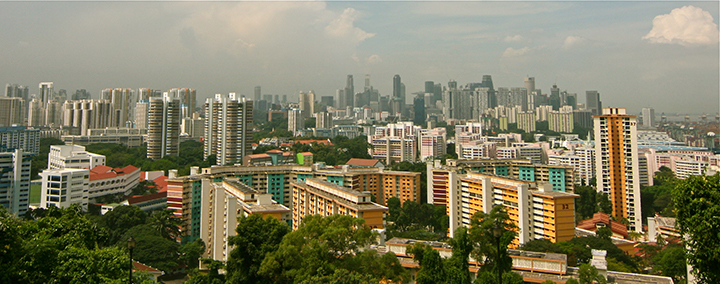
Singapore’s residential districts largely reflect the high-density city concept7
2. Built Environments for Active Ageing
Among middle-aged and elderly residents in Singapore, walking is by far the most enjoyable physical activity, followed by running, swimming, generic body workout, bicycle touring and calisthenics10. Based on the residents’ perception Singapore appears to provide its older inhabitants with the required urban space and facilities for active lifestyle. Only around 5% of residents stated that amenities are too far away from their residence and less than 2% of them indicated that the present facilities are not suitable9, implying that generous built environments for physical activity, exercise, and recreation are offered in this large, high-density city.
In Singapore the city parks, sports complexes, outdoor fitness zones, park connectors and community clubs can be identified as the key active ageing-enabling urban features7. The physical foundation for this urban health policy was laid in the first comprehensive city plan for an independent Singapore in the late 1960s25,26. Embedding health-supportive public facilities and green space for sports and exercise into the city’s rapidly developing urban landscape has ever since been one of the key elements of the government’s centralized urban planning strategy27, facilitating young and old residents to pursue active lifestyle in close proximity to their residence. In the following decades Singapore had created largely self-sufficient population centres that are characterized by uniform, egalitarian residential areas consisting of high-rise public housing estates, the so-called New Towns (or just Towns) or better called HDB-districts (the acronym HDB stands for the Housing Development Board, a statutory board of the Singapore government that manages all public housing estates). The urban layout of these HDB-districts follows a standardized land-use distribution formula, thereby guaranteeing almost identical sports and exercise facilities across most districts28,29 – standardization in land use planning is one of the key characteristics of the Socialist City urban planning concept30,31,32. And to this day these government-subsidized HDB-residential districts form the core pillars of the city’s social fabric, representing residential areas in which 82 per cent of the local population still lives33. By contrast, the provision of medium- to large-sized city parks between the clusters of the physically separated HDB-districts complies with Ebenezer Howard’s principles of the Garden Cities urban planning concept.
Over years the Singapore government has continued to expand the availability of publicly-subsidized facilities, infrastructure and green space for active ageing across the entire city-state as part of the National Public Health Promotion that was initiated in 1992. Its centralized planning of active ageing-enabling built environments may suggest that the government’s top-down approach has been a crucial element of delivering a public good that has facilitated the popularization of the city’s active ageing lifestyle. Hence, Singapore’s key urban features for exercise and recreation will be briefly outlined.
City Parks
A substantial proportion of Singapore’s land area has been allocated to public city park development, thereby offering older residents ample green space for exercise and recreation and presenting other high-density cities with an inspiring case study for incorporating parklands into city planning. This tropical city presently contains 275 small-sized neighbourhood parks and a generously high number of 62 medium- and large-sized regional parks (the latter amount to 3,130 ha)34. Being methodically integrated into the high-density, high-rise public housing estates, the neighbourhood parks are mostly designed for day-to-day use35. By contrast, the larger city parks regularly serve as segregation zones between residential districts.
These large-sized city parks, in particular, could be regarded as one of the city’s greatest active ageing assets due to the integration of amenities for physical activity into the parks’ design. They contain designated trails for walking, running and cycling as well as numerous outdoor fitness stations. In addition, the most popular large city parks are accessible via an expansive network of paved trails, the so-called park connectors, that criss-crosses the urban island (see ‘Park Connectors’ below).
In all, Singapore offers their older inhabitants a variety of outstanding parks for exercise and recreation purposes. And the most impressive city parks in terms of size and amenities appear to be the large East Coast Park, Bishan-Ang Mo Kio Park, Bedok Reservoir and the Bukit Timah Nature Reserve36.
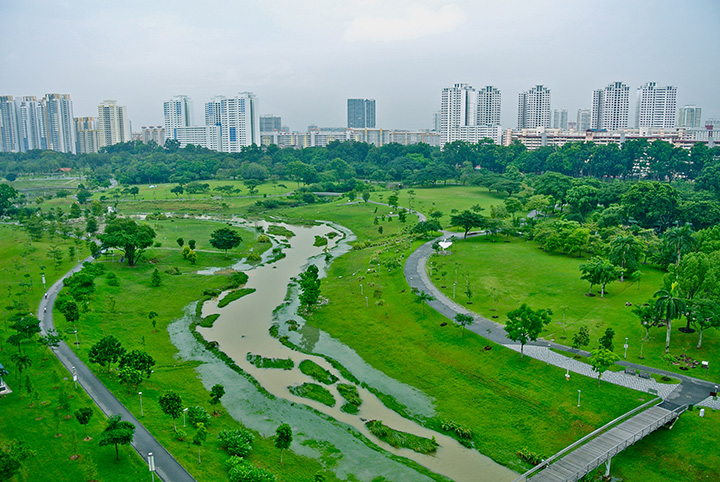
Bishan-Ang Mo Kio Park is one of the largest city parks for physical activity and exercise
Community Sports Complexes
Most HDB-public housing districts in Singapore provide their older residents with a standardized sports complex, typically consisting of a track and field stadium, multi-purpose-built indoor sports hall, Olympic-size outdoor swimming pool and an indoor fitness gym. Currently, there are 22 outdoor swimming centres with Olympic-size pools, 16 large-sized stadia, 15 indoor sports halls and 16 fitness gyms37. These key government-subsidized sporting facilities are fairly evenly distributed across Singapore, implying that the city-state’s government aspires to provide equal accessibility to active ageing options.
The utilization of the track and field lanes in the stadia is free of charge. Older Singapore residents usually visit these facilities for running or walking purposes predominantly during the early morning and late evening hours. The indoor sports halls are normally utilized for badminton and table tennis – racquet games that are perfectly suitable for active ageing. By contrast, the relatively small indoor gym facilities are mostly crowded with young residents, suggesting little interest in heavy weights-based body workout among older Singaporeans.
Outdoor Fitness Zones
The systematic provision of free-of-charge, all-weather outdoor stationary fitness facilities is another active ageing-supportive urban feature in Singapore. The large majority of these publicly accessible gym areas are installed within HDB-public housing estates, in city parks, around sports complexes, at school campuses and along park connectors7,38.
This city-wide installation of outdoor gym facilities is an admirable active health urban policy, demonstrating the city-state’s objective to ensure equal and within-walking-distance accessibility of amenities for fitness and exercise. As a result, older residents from different socio-economic backgrounds can, at no cost, enhance their overall physical fitness including strength, flexibility, balance and endurance. The fitness equipment installed across Singapore can be generally categorized in five types: fixed, low-resistance endurance stations, flexibility- and balance-enhancing stations, body weight-dependent, strength stations, resistance-invariable strength machines and resistance-adjustable strength machines.
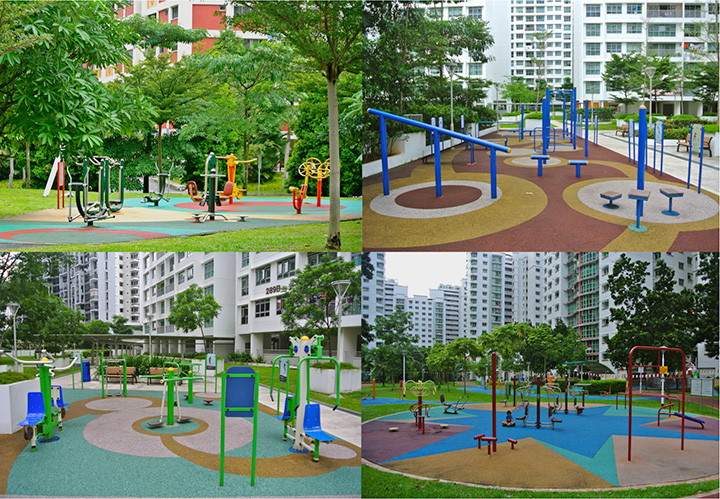
Examples of typical larger outdoor fitness zones integrated into HDB-districts
For older people, the most suitable gym stations are the resistance-invariable strength machines, the fixed, low-resistance endurance stations and the flexibility- and balance-enhancing stations. On the easy-to-use strength machines, such as lateral pull down, leg press or seated chest press, the body-weight of the user serves as a personalized, non-adjustable intensity level. The elliptical cross-trainers and sky runners are the most common fixed, low-resistance (and low-joint-pressure) endurance stations, aiming at seniors with musculoskeletal complications who are keen on improving cardio-vascular functions and reducing body weight. The flexibility- and balance-enhancing stations, such as the shoulder flexor, Tai Chi wheel, balancing beam and body twister, are the standard fitness equipment options, specifically tailored to the needs of able and physically challenged older residents.
Taken together, the installation of outdoor fitness equipment across Singapore is an impressive, yet largely undervalued active ageing health policy. To the urban planners’ credit, the outdoor fitness zones that are integrated into the HDB-public housing estates, in particular, are designed to be easily accessible for wheelchair-bound users. This urban health concept therefore deserves to be sustained and promoted as a key component of Singapore’s future active ageing lifestyle.
Park Connectors
Since the early 1990s Singapore has been constructing an expansive network of paved trails lined with plantings and ornamental trees across the entire city39. These so-called park connectors serve as convenient recreational zones for older joggers, walkers and cyclists. By providing structural links between large city parks, these trails also enable residents to prolong their physical activities and explore other parts of the city. At present, there are approximately 70 park connectors, reaching a total length of 303 kilometres of free-of-charge space for physical activity and recreation34.
Although some of the park connectors display various structural weaknesses, such as the re-occurring traffic lights at road crossings and ‘Dismount and Push’ bicycle signs along underpasses and overhead bridges, the park connectors and their continuously enhanced functionality can, by and large, be hailed as a success story.
In all, Singapore’s urban planners have succeeded in integrating an extensive network of trails into the entire city’s layout, providing large numbers of older residents with ample public space for recreation and exercise. Thus the park connectors network is yet another urban planning feature in this large, compact city that deserves to be incorporated into its future active ageing lifestyle strategies.
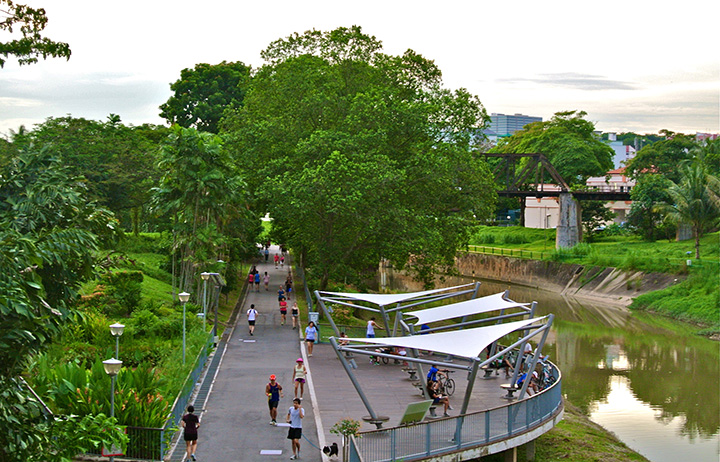
Park Connectors are particularly popular with local joggers, recreational cyclists and walkers
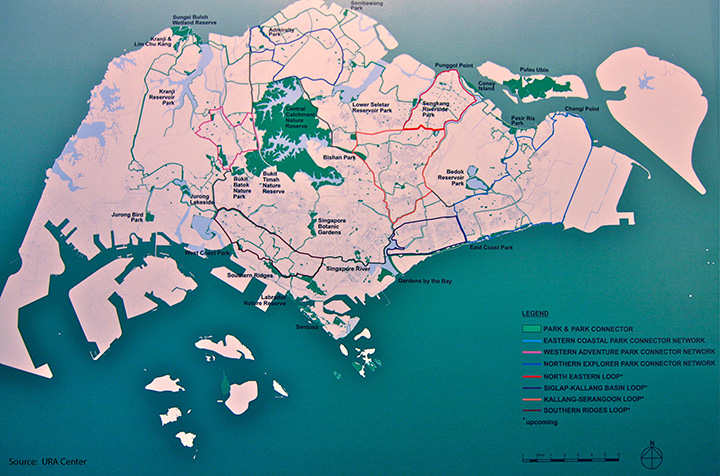
Map of Singapore at the URA centre demonstrates the present park connectors network
Community Clubs
Across all HDB-public housing estates there are currently 108 mid-sized, multi-functional community clubs40, which provide predominantly older local residents with additional, affordable options for recreation, fitness and exercise. These government-associated facilities typically comprise of basic indoor amenities for table tennis, badminton, dancing, yoga and gym workout as well as one outdoor basketball court. The clubs also organised various active ageing programmes for physical activity and wellness, ranging from walking for health events, yoga and dancing classes, tai chi courses to bowling games. Besides, all residential HDB-public housing estates contain the so-called ‘under the block’ HDB-indoor services where programmes for older residents with advancing age-related mobility restrictions are offered on almost daily basis.
3. Conceptual Framework
Participating in lifelong physical activity will be a fundamental aspect of healthy city living among the increasingly ageing urban populations. Given its projected population growth and ageing society trends, providing the next generation of older Singapore residents with sufficient green space and adequate facilities for physical activity and recreation in this large, high-density South-East Asian city will hence emerge as the key precondition for an effective transformation into a prospective Active Ageing Singapore.
To advance this multifaceted area of Active Ageing Cities and to embody the real complex nature of urban studies and city liveability, the proposed framework approaches this public health subject from a unifying, cross-disciplinary perspective41,42, thereby capitalizing on the overall knowledge intensification through the interrelatedness and cross-pollination of various disciplines. Thus the foundation of potential strategies for the maturation of Active Ageing Singapore requires the adoption of a synergistic method.
This proposed conceptual framework comprises of six key determinants outlining the fundamental physical attributes: affordability, diversification, functionality, accessibility, locality and regulation. These determinants are interlinked and could potentially serve as the basis for Singapore during its formation process of establishing an urban active ageing hub – a top-tier Active Ageing City.
Affordability
In Singapore the utilization of non-private sports, physical activity and exercise services is either free-of-charge or fairly reasonably priced. For instance, small-sized outdoor games courts and outdoor fitness stations – typically located within HDB-public housing estates – can be used for free. The same applies to all city parks and the popular running tracks at the HDB-sports complexes. All the other government-subsidized sports facilities are priced moderately, with S$ 0.50 swimming being the most affordable physical activity for seniors among all the other chargeable options (see Chart 2). It is also worth stating that only less than 2% of seniors believe that the costs of facilities are an impediment to physical activity participation9.
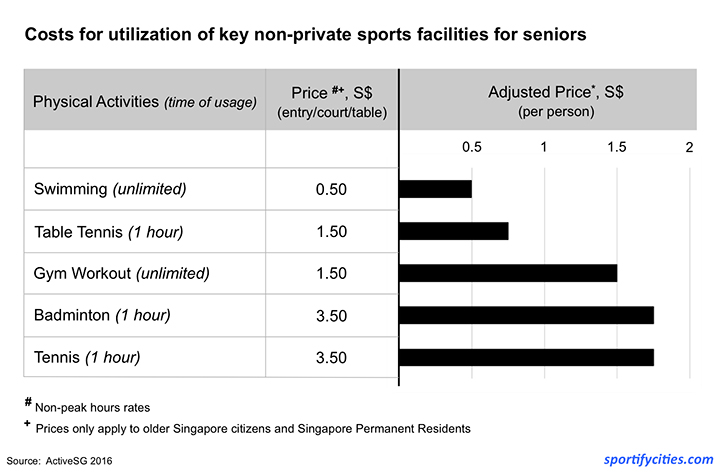
Chart 2. Utilization costs for selected key physical activities – Singapore residents aged 60 years and above43.
Given that 83% of physically active HDB-residents choose public space and government-subsidized facilities as their preferred active lifestyle locations9, securing the affordability of these amenities would therefore be a key element of a potential Active Ageing Singapore strategy. That said, privately operated fitness clubs, squash courts or golf courses, among others, have grown in popularity and they often offer comfier, yet pricier active ageing lifestyle options. Besides, the utilisation of a disproportionately large number of existing facilities, for instance, indoor fitness gyms, small-sized swimming pools as well as tennis and squash courts, has been limited exclusively to residents living in private condominiums44 – yet these private high-rise residential apartments account for only 14% of Singapore’s resident households6.
This steadily growing accessibility imbalance could perhaps be regarded as a reflexion of Singapore’s broader socio-economic circumstances. After all, Singapore has been experiencing a progressively increasing inequality in income and wealth distribution since the late 1990s, exemplifying a socio-economic trend observed in many other developed and emerging countries45,46. It remains unclear, however, whether in future the growing imbalance in provision of public and private sports facilities as well as the inequality in income and wealth distribution could become a physical activity impediment in Singapore. Given that larger numbers of middle-aged Singapore residents attain greater middle-class purchasing power compared to the previous generations, that is, the current retirees, due to higher incomes and higher labour force participation rates47, this future retirement age group will most likely be able to spend more on active ageing lifestyle than the present generation of local seniors.
Diversification
In Singapore older people confine their active ageing participation to a limited number of popular physical activities – with walking being, by far, the most preferred activity among older city residents (20% of all residents aged 60 and above)9 (see Chart 3). This predominance of walking may suggest that greater diversification of active ageing options is required. A good example of diversification is the provision of outdoor gym areas containing a large variety of easy-to-use fitness stations that are installed along trails for running and cycling, enabling older people to enhance their overall physical fitness.
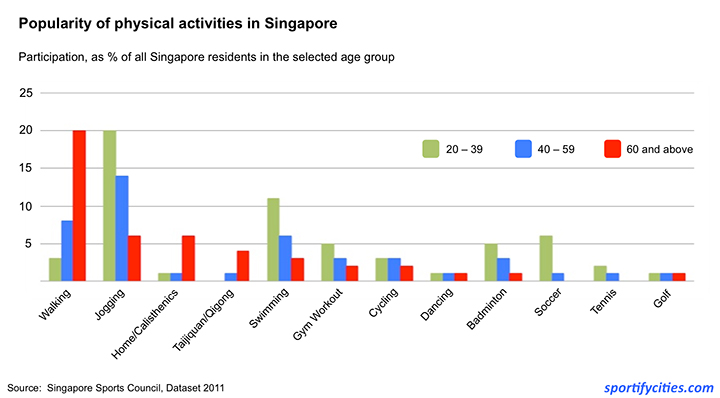
Chart 3. Popularity of physical activities in Singapore by age-group9
In order to increase the utilization rates of city parks among older residents, for instance, some of the existing medium- and large-sized city parks could undergo structural alterations by complementing these selected parks with a variety of active ageing-suitable amenities. By applying the aspects of multifunctionality, centralisation, compactness and diversification, designated sections of the nominated parks could be transformed into Active Ageing Parks. This would potentially lead to a far livelier park atmosphere and to a changing nature of the city parks’ active ageing lifestyle. In doing so, the slightly monostructural city parks would obtain more of a diverse character, thereby realizing the full potential of the valuable, health-enhancing green space in Singapore. After all, greater diversity of facilities within park areas is generally associated with greater utilization levels among physically-active residents22. As for Singapore a likely case study for an Active Ageing Park could be the recreational areas around the mid-sized Bukit Panjang Park located in the city’s north-western district of Bukit Panjang; the Senja-Cashew community club with its outdoor swimming pool, indoor sports hall for badminton and table-tennis, indoor gym facilities and dance studios is loosely integrated into the adjacent city park.
According to the recent government announcements, five new Regional Sports Centres or so-called ‘Lifestyle Hubs’ will be constructed by 2030 (they will partially replace the existing sports complexes, however). These Regional Sports Centres consisting of the usual facilities such as outdoor swimming pools, tennis courts, indoor sports halls and fitness gyms48, could perhaps help alter the status quo and dominance of the top three physical activities among older Singaporeans – i.e., walking, running and calisthenics. Yet by merely replicating active ageing lifestyle strategies that predominantly offer Singapore’s well-established standardized supply of facilities, this conventional approach will most likely do little to significantly diversify future active lifestyle options for older locals.
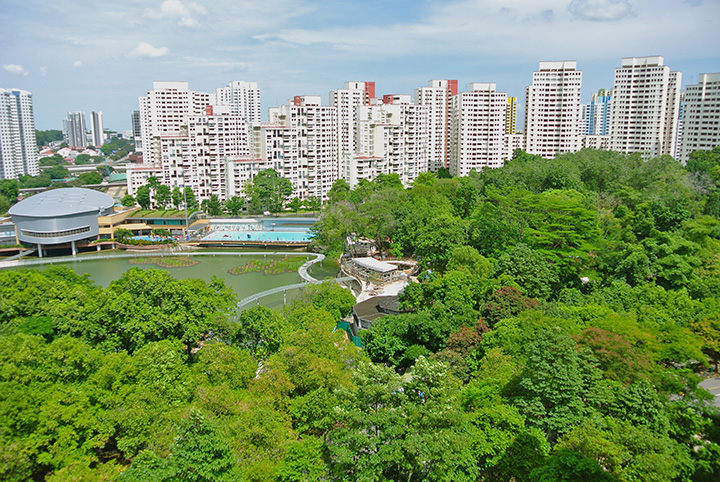
The integration of the HDB-sports complex into the medium-sized Bukit Panjang Park is a plausible model for future Active Ageing Parks in Singapore.
Functionality
Active Ageing Singapore will require a substantial number of age-supportive amenities and infrastructure that comply with the functionality aspect of ageing individuals. Policymakers are particularly advised to factor in the health-associated principles of orthopaedics, biomechanics and cardiology when developing potential strategies. For instance, the age-related functionality of trails in some of the prime city parks could be improved by constructing gravel trails. In designing softer, unpaved trail surfaces suitable for older joggers (such as the formidable gravel trail in the Bedok Reservoir located in the eastern districts), the cumulative impact of running on hip and knee joints could be reduced among middle-aged and older recreational joggers. In the long run, the availability of age-suitable trails could potentially enable more residents to pursue running into their older age. With 28% recreational running is the second most popular physical activity – after walking – among physically active middle-age residents10. Thus it is plausible that a substantial number of these runners are keen on enjoying this physical activity beyond their retirement age. This assumption should therefore be taken into account when establishing any future Active Ageing Singapore strategy.
More emphasis could also be put on amplifying the multi-functionality and age-suitability of HDB-outdoor gym areas. This would give older users of these free-of-charge fitness stations the opportunity to optimize the potential health benefits by choosing fitness tasks according to their individual and age-related demands. In this way, high-quality returns and efficiency – that is, the greatest overall physical fitness and health benefits relative to the individual’s invested time – would be ensured.
Accessibility
Singapore residents preferably utilize active lifestyle options that are located conveniently around their neighbourhood, such as community clubs, small neighbourhood parks, small HDB-sports grounds and outdoor fitness areas9. Thus convenient, equal and age-suitable accessibility of facilities and green space for physical activity and recreation must be preserved across all districts in the prospective Active Ageing Singapore. If the recent trend towards declining per capita supply of the key HDB-sporting facilities continues (see Chart 4), however, the accessibility levels will not be sustained (the number of facilities located in HDB-public housing estates has plateaued over the past 15 years, while Singapore’s overall population has risen by 1.5 million during the same period). This divergence will eventually result in more limited within-walking-distance accessibility for larger shares of its population, giving rise to more unequal and less diverse active ageing lifestyle opportunities due to increasingly inconvenient accessibility.
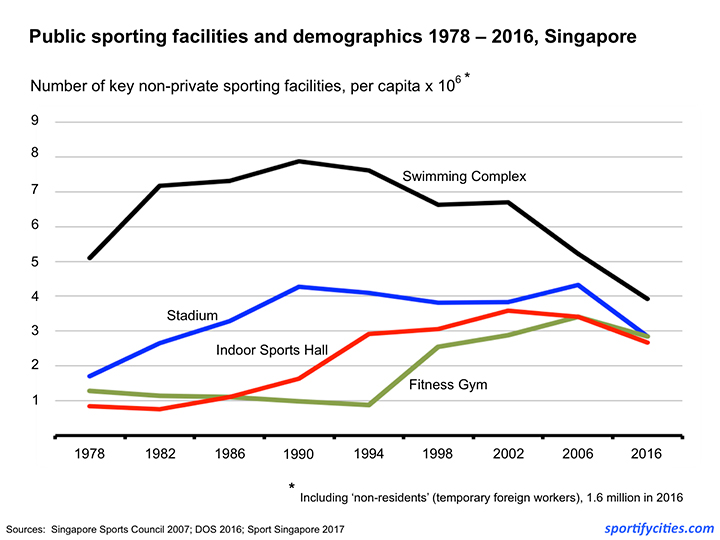
Chart 4. Provision of key public facilities for exercise, sports and recreation37,44,49
Furthermore, Singapore’s population is projected to grow from currently 5.5 million to nearly 7 million by 20308. To secure in-close-proximity amenities, this population growth prediction should lead to a major overhaul of the existing HDB-sports complexes and initiate a conversation of potentially de-centralizing some parts of future HDB-sporting facilities. Such de-centralisation of the next generation of HDB-sporting centres could be an alternative approach to improving accessibility of active ageing amenities for older and physically challenged residents. Additional active lifestyle centres of smaller sizes, for instance, could be created across all HDB-residential districts, thereby offering more within-walking-distance active ageing options. Evidently, these recommendations would require land-use planning alterations to the current zoning regulations.
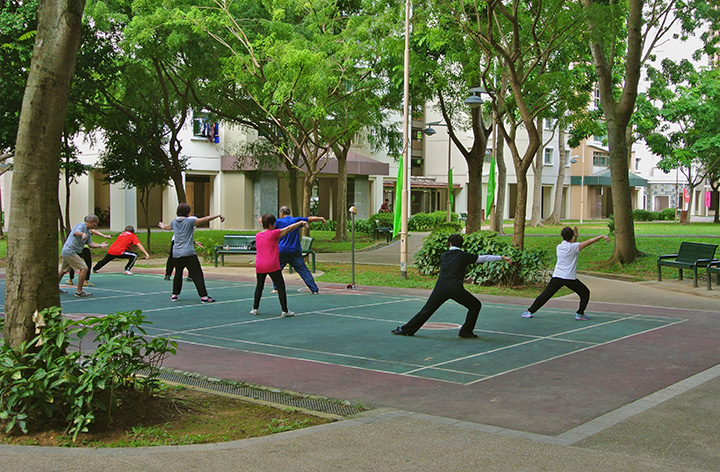
Older residents practising Tai Chi in the morning hours. Small sports grounds are systematically integrated into the HDB-public housing estates across the city.
In Singapore older physically-active residents typically walk to the HDB-public sports facilities, community clubs and city parks. And they generally display little interest in using a bicycle – an affordable and convenient transportation mode – when accessing active lifestyle amenities. A study on Singaporeans aged 50 years and above appears to confirm these observations regarding transportation preferences, with 85% of residents choosing to walk to the local exercise facilities50.
Although most key HDB-sports facilities and medium- to large-sized city parks are accessible via the city’s first-rate metro train and bus network, physically-active seniors may however find these transportation options rather inconvenient. Driving to the key active lifestyle amenities, for instance, certainly improves accessibility. Due to the various taxes and fees that are added to the usual market price of a motor vehicle, however, the overall costs for purchasing a new, medium-size engine car in Singapore can easily exceed the extraordinarily high amount of S$ 150.000. And still, 42% of households own a car51, implying that a sizeable proportion of Singapore residents are prepared to pay exorbitant prices for owning a car in exchange for greater mobility, convenience and A/C comfort.
As the likelihood of owning a private car in Singapore is increased by virtue of higher income or greater wealth, enhanced accessibility of active lifestyle facilities is associated with greater financial means. This economic factor will limit the accessibility of future retirees due to their usually reduced purchasing power during the retirement phase. More importantly, two thirds of HDB-public housing households – the living space for 82% of Singapore residents – do not possess a private car51. Improved car-independent access to age-suitable facilities as well as to large city parks will therefore become a critical element of any future active ageing strategy in Singapore.
To the city planners’ credit, the construction of two more train lines will be completed by 2024, improving the connectivity to the four large city parks, i.e., the East Coast Park, Bedok Reservoir, Bishan Park and the Bukit Timah Nature Reserve. Although it is still in formative stages, Singapore has also been investing into the implementation of driverless transportation systems. Thanks to its compact and integrated urban layout the city may soon become the first world city to incorporate overlapping transportation systems and fully autonomous multi-modal transportation networks into its future city living environment, potentially narrowing the active ageing accessibility gap.
Locality
To ensure the pervasiveness of adequate active ageing options for urban ageing societies, physical activity-supportive built environments must reflect the local geographical and topographical circumstances. Singapore, for instance, is located in the tropical rainforest climate zone. Due to its high ambient temperatures and high humidity levels this zone appears to offer rather unsuitable conditions for active ageing lifestyle. After all, this non-modifiable factor, i.e., hot and humid climate all-year-round, creates challenging meteorological environments for older residents by increasing the risk of medical emergencies due to hyperthermia-caused diminished response of the cardio-respiratory system52.
In Singapore the maximum air temperatures – measured in the shade – typically exceed 32°C in the afternoon hours, while the relative humidity levels remain relatively high even on dry and sunny days, barely dropping below the 50% levels53. At night air temperatures barely drop below 27°C and the humidity levels regularly remain above 80% (for more detailed information on exercising in tropical climate in Singapore, see Sportify Cities special report on Singapore54). Furthermore, when factoring the weighty influence of wind speed and humidity into the standard air temperatures recorded in Singapore, the tangible heat levels become even more extreme. In this regard, the assessment of the ‘feels like’ or ‘perceived’ temperature is more telling, as it takes into account these two meteorological variables. For instance, in Singapore the recorded air temperature of 32°C can actually be perceived as 45°C, whereas in some other parts of the world the other variables have less impact on the feels like temperatures54,55 (see Chart 5).
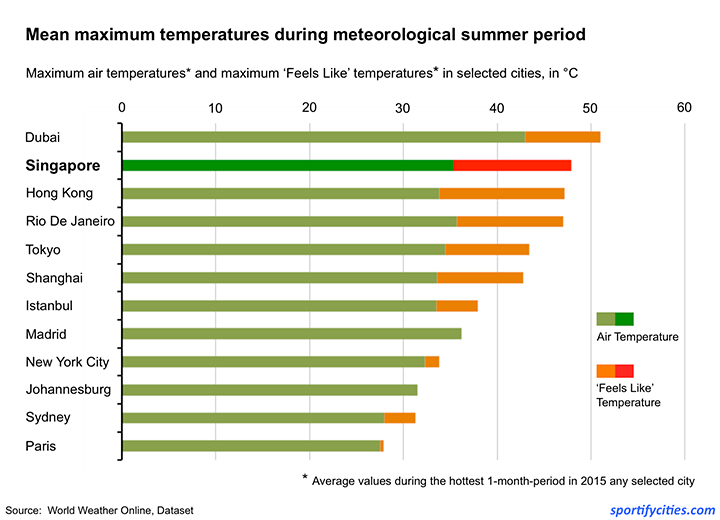
Chart 5. Comparative feels like temperatures in selected cities offer a real-life reference point in regard to the actually perceived heat levels54,55.
Although Singapore residents are more acclimatized to hot and humid conditions compared to the so-called non-tropical natives, the scale of the perceived heat levels continues to influence the daily rhythm of its residents and the choice of their physical activities. That said, the city’s challenging meteorological conditions do not seem to deter older Singapore residents from participating in active lifestyle9. In choosing the slightly more pleasant early morning and evening hours for their exercising, older residents have largely come to terms with the tropical climate. Besides, it can be assumed that local residents are mindful of the number of conventional strategies for making exercising under hot and humid conditions more comfortable, such as cooling, sufficient fluid intake and adequate clothing. Nevertheless, some of the present facilities, such as the outdoor fitness areas, could offer inexpensive, sun-protective shade sails and solar-powered fans, thereby reducing the users’ exposure to extreme UV-solar radiation and heat levels while performing fitness tasks.
Despite the available options of carrying out numerous physical activities in more comfortable air-conditioned indoor facilities, the ten most popular activities among older Singaporeans are undertaken in outdoor environment, bar indoor gym workout and home exercising9. Fortunately, outdoor active ageing lifestyle can easily be pursued before dawn and after dusk due to the extensive lighting provided in city parks and along park connectors, giving Singapore the opportunity to potentially popularise Twilight Active Ageing as a prospective element of the city’s profile and branding.
At present, however, the city parks are not entirely attuned to the local warm, tropical climate – that is, they do not provide older residents with an experience that reflects the uniqueness of this locality. Thus the incorporation of the local climate into the future Active Ageing Singapore strategies will be an essential aspect of successfully initiating and consolidating a distinctive city image. By integrating local, tropical elements into its tropical-style park design, such as outdoor table-tennis or beach badminton, for instance, Singapore’s parks could become unique identifiers of the city’s distinctive active ageing lifestyle initiative.
Regulations
Older Singapore residents largely prefer to participate in outdoor physical activities. In order to be able to continue enjoying outdoor active ageing, the quality of the city’s air will have to be preserved or even improved. Since high levels of air pollution have been associated with posing greater health risks to older people and people with medical preconditions56,57, the establishment of a workable active ageing-built environment strategy will heavily rely on the city’s air quality.
The environmental movement, which has its origins in the developed countries in the 1960s and 1970s, has had a long-lasting impact on Singapore, eventually encouraging it to adopt standard environmental regulations to keep its man-made air pollution at tolerable levels. Singapore also regulates its urban pollution through rigid car-restricting policies58,59, discouraging their residents from purchasing and using private cars (with 104 private cars per 1,000 inhabitants the city demonstrates one of the lowest ownership rates in the developed world)49. Furthermore, the city’s running trails and outdoor active ageing facilities – which are constructed in city parks, residential areas and along water canals – are mostly located at a safe distance from main roads, reducing the levels of exposure to hazardous exhaust fumes. By and large, Singapore offers satisfactory environmental conditions for outdoor physical activities, displaying fairly low air pollutants levels throughout the year60.
That said, for decades now Singapore has been exposed to hazardous smoke haze originating from deliberately set fires that rage across the Indonesian archipelago, significantly increasing the levels of some of the key pollutants and affecting the daily life and health of its local residents. The long lasting and unusually severe haze season in 2015, for instance, restricted older residents in their outdoor activities for as long as nearly 3 months61,62 (see Chart 6). Overall, however, Singapore’s air quality levels appear acceptable for physical activity and active ageing lifestyle. With 18 μg/m3 Singapore demonstrates the lowest annual PM2.5 value – a valid parameter for urban pollution – of all large cities in Asia, bar the Japanese metropolitan areas63,64,65, highlighting its efforts in managing its domestic air pollution. And if the city maintains (or even enhances) its air quality levels, its older residents will be able to utilize the available outdoor urban features and enjoy outdoor physical activities without being concerned about possible health implications.
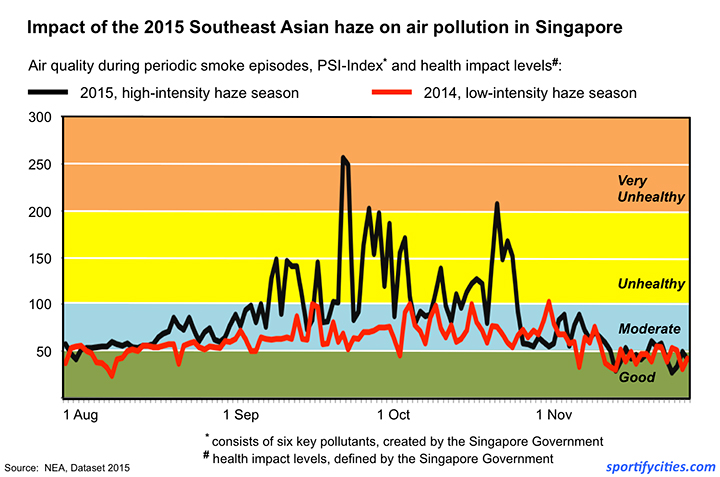
Chart 6. Impact of the 2015 haze season on Singapore’s air quality61,62
4. Marketability Potential
For these Active Ageing Singapore elements to be effectively implemented, the government would have to demonstrate political ambition by setting out a defining, long-term strategy. Given the complexity of such an undertaking, the chief aim of local policymakers should hence be to form a cross-disciplinary teamwork of experts and make a concerted effort to unify the present knowledge and original ideas prevailing in various essential disciplines – ranging from physical activity and exercise, urban studies, and gerontology to cardiology, atmospheric sciences and technology. It would furthermore require an effective collaboration among the various statutory boards of the Singapore Government such as the Urban Redevelopment Authority, Singapore Land Authority, Housing and Development Board, Health Promotion Board, National Park Board, Sports Singapore, Public Transport Council and the Land Transport Authority.
By incorporating the inseparably intertwined physical attributes outlined in this proposed framework, Singapore could create a distinctive city branding that is risky, yet unique. After all, cities across the globe are still rather reluctant to associate themselves with the aspect of ageing. Hence, a maturing Active Ageing Singapore could potentially help boost the societal acceptance of ageing cities worldwide by inspiring other cities to incorporate the most suitable active ageing ideas and strategies into their own cities.
Singapore could potentially become the world’s laboratory for active ageing lifestyle in high-density urban settings. And given the general health benefits of physical fitness-oriented land use planning, the progressively ageing urban populations in the developed world and the quantifiable trend towards embracing the active lifestyle aspects among city residents, Singapore could seize the moment by eventually manifesting itself as an active ageing lifestyle hub in high-density city settings that could become an inspiration for other Asian cities and beyond.
Besides, being one of the top-tier world cities with a high marketability and recognisability factor, Singapore should start embracing the potential value of its own demographic trend, active lifestyle boom among locals and its high-density urban landscape. Since liveability of ageing urban populations in densely populated cities and the emergence of healthy active lifestyle are likely to globally emerge as the key city themes in the 21st century, Singapore could position itself as a household name and point of reference for active ageing living by adding this aspect to its city liveability equation. The conception of a distinctive, recognisable and memorable city profile and branding could also help attract health-conscious, affluent foreign residents who would potentially consider Singapore to become their location of choice for retirement. In this regard, the provision of the city’s world-class health care services would certainly be a useful marketing tool to achieve this objective.
Again, by offering active ageing and physical activity-supportive built environments across its districts, Singapore has laid the foundation for becoming an inspirational Active Ageing City. And given the city’s progressively ageing society and its ongoing urban densification, this proposed framework could potentially serve as a basis for novel active ageing lifestyle strategies tailored to the demands of its increasingly health-conscious, affluent residents.
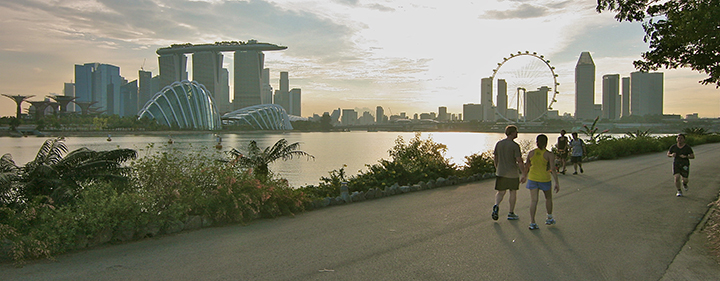
References
1 EIU: Best cities ranking and report. A special report from the Economist Intelligence Unit. The Economist Intelligence Unit Ltd: London, 2012.
2 EIU: Hot spots 2025. Benchmarking the future competitiveness of cities. A report from the Economist Intelligence Unit. The Economist Intelligence Unit Ltd: London, 2013.
3 Mercer: 2016 Quality of living rankings. 2016. Available at: https://www.imercer.com/content/mobility/quality-of-living-city-rankings.html (accessed 15 April 2017)
4 PWC: Cities of opportunity 7. Report. New York, 2016.
5 United Nations: Ageing. Department of Economic and Social Affairs – Population Division. 2017. Available at: http://www.un.org/en/development/desa/population/theme/ageing/index.shtml (retrieved 20 April 2017)
6 DOS: Population trends 2016. Department of Statistics, Ministry of Trade and Industry, Republic of Singapore, 2016.
7 Szubski C: Sporting Lifestyle in Singapore – Centralized urban planning and the making of a potential hub for physical activity, sports and exercise. Sportify Cities – Guidelines and Strategies. Sportify Cities, 2017. Available at: https://sportifycities.com/sporting-lifestyle-singapore/ (retrieved 11 June 2017)
8 White Paper: A sustainable population for a dynamic Singapore. Population White Paper. National Population and Talent Division, Prime Minister’s Office. Singapore, 2013.
9 Singapore Sports Council: National sports participation survey 2011. Final report. Singapore, 2011.
10 Sport Singapore: Sports index – Participation trends 2015. Singapore, 2016.
11 Running Guild: Calendar of running events in Singapore. 2017. Available at: http://www.runningguild.com/index.php/runningcalendar/ (retrieved 20 April 2017)
12 Bhalla V, Fong CV, Chew SK, Satku K: Changes in the levels of major cardiovascular risk factors in the multi-ethic population in Singapore after 12 years of a national non-communicable disease intervention programme. Singapore Medical Journal 47(10): 841-850, 2016.
13 Carvalho A, Maeve Rea I, Parimon T, Cusack BJ: Physical activity and cognitive function in individuals over 60 years of age: a systematic review. Clinical Interventions in Aging 9: 661-682, 2014.
14 Bauman A, Merom D, Bull FC, Buchner DM, Fiatarone Singh MA: Updating the evidence for physical activity: Summative reviews of the epidemiological evidence, prevalence, and interventions to promote “Active Aging”. Gerontologist 56(Suppl2): S268-280, 2016.
15 Mendonca GV, Pezarat-Correla P, Vaz JR, Silva L, Almeida ID, Heffernan KS: Impact of exercise training on physiological measures of physical fitness in the elderly. Current Aging Science 9(4): 240-259, 2016.
16 Cadore EL, Pinto RS, Bottaro M, Izquierdo M: Strength and endurance training prescription in healthy and frail elderly. Aging and Disease 5(3): 183-195, 2014.
17 Hwang PW and Braun KL: The effectiveness of dance interventions to improve older adults’ health: a systematic literature review. Alternative Therapies in Health and Medicine 21(5): 64-70, 2015.
18 Bouaziz W, Lang PO, Schmitt E, Kaltenbach G, Geny B, Vogel T: Health benefits of multicomponent training programmes in seniors: a systematic review. The International Journal of Clinical Practice 70(7): 520-536, 2016.
19 Youkhana S, Dean CM, Wolff M, Sherrington C, Tiedemann A: Yoga-based exercise improves balance and mobility in people aged 60 and over: a systematic review and meta-analysis. Age and Ageing 45(1): 21-29, 2016.
20 Hallal PC, Bauman AE, Heath GW, Kohl 3rd HW, Lee I-M, Pratt M: Physical activity: more of the same is not enough. Lancet 380: 190-191, 2012.
21 Lee H, Kang HM, Ko YJ, Kim HS, Kim YJ, Bae WK, Park S, Cho B: Influence of urban neighbourhood environment on physical activity and obesity-related diseases. Public Health 129(9): 1204-1210, 2015.
22 Kaczynski AT, Potwarka MA, Saelens BE: Association of park size, distance, and features with physical activity in neighborhood parks. American Journal of Public Health 98(8): 1451- 1456, 2008.
23 Prins RG, Van Empelen P, Te Velde SJ, Timperio A, Van Lenthe FJ, Tak NI, Crawford D, Brug J, Oenema A: Availability of sports facilities as moderator of the intention-sports participation relationship among adolescents. Health Education Research 25(3): 489-497, 2010.
24 Wong BY, Ho SY, Lo WS, Cerin E, Mak KK, Lam TH: Longitudinal relations of perceived availability of neighbourhood sport facilities with physical activity in adolescents: an analysis of potential moderators. Journal of Physical Activity and Health 11(3): 581-587, 2014.
25 Olszewski KF and Skeates R: Singapore’s long-range planning. Royal Australian Planning Institute Journal 9(2): 57-70, 1971.
26 Wardlaw H: Planning in Singapore: The United Nations renewal and development project. Royal Australian Planning Institute Journal 9(2): 45-47, 1971.
27 Teo L: Singapore. In: Nicholson M, Hoye R and Houlihan I (Eds): Participation in Sport: International Policy Perspectives. Routledge, pp. 183-208, 2011.
28 Field B and Smith J: Singapore. City profile. Cities 3(3): 186-199, 1986.
29 Hee L and Ooi GL: The politics of public space planning in Singapore. Planning Perspectives 18(1): 79-103, 2003.
30 Fisher JC: Planning the city of socialist man. Journal of the American Institute of Planners 28(4): 251-265, 1962.
31 Abrams I and Vigfia RF: Urban planning in Poland today. Journal of the American Institute of Planners 41(4): 258-269, 1975.
32 Underhill JA: Soviet new towns, planning and national urban policy: shaping the face of the Soviet cities. The Town Planning Review 61(3): 263-285, 1990.
33 HDB: Key statistics. HDB annual report 2015/2016. Housing and Development Board. Republic of Singapore, 2016. Available at: http://www10.hdb.gov.sg/eBook/AR2016/key-statistics.html (retrieved 11 April 2017)
34 National Parks: Green matters. Annual report 2015/16. Singapore, 2016.
35 Yuen B: Use and experience of neighbourhood parks in Singapore. Journal of Leisure Research 28(4): 293-310, 1996.
36 Szubski C: City parks. Chapter 3. In: Singapore – A high-density city with sporting characters. Special report. Sportify Cities, 2016. Available at: https://sportifycities.com/singapore-city-parks/ (retrieved 1 June 2017)
37 Sport Singapore: SportSG sport facilities. 2017. Available at: https://data.gov.sg/dataset/sportsg-sport-facilities (retrieved 14 April 2017)
38 Szubski C: Outdoor fitness stations. Chapter 6. In: Singapore – A high-density city with sporting characters. Special report. Sportify Cities, 2016. Available at: https://sportifycities.com/singapore-fitness-zones/ (retrieved 1 June 2017)
39 Yuen B, Kong L, Briffett C: Nature and the Singapore resident. GeoJournal 49(3): 323-331, 1999.
40 People’s Association: Community clubs. Singapore, 2016. Available at: https://www.pa.gov.sg/Our_Network/Community_Clubs (retrieved 4 April 2017)
41 Johnson S: Emergence. The connected lives of ants, brains, cities, and software. Scribner, 2001.
42 Capra F: The hidden connections. Integrating the biological, cognitive, and social dimensions of life into a science of sustainability. Doubleday: New York, 2002.
43 ActiveSG: Facilities – Individual rates. Sport Singapore. 2016. Available at: https://www.myactivesg.com/facilities/sport-centres/individual-rates (retrieved 8 April 2017)
44 Singapore Sports Council: A census of sports facilities in Singapore, 2006. Communications & Knowledge Group: Singapore, 2007.
45 Piketty T: Capital in the Twenty-First Century. Belknap Harvard, 2014.
46 WID World: World wealth and income database. 2017. Available at: http://wid.world/data/ (retrieved 29 March 2017)
47 Ministry of Manpower: Labour force in Singapore 2016. Manpower Research and Statistics Department. Republic of Singapore, 2016.
48 MCCY: Sports facilities master plan. Ministry of Culture, Community and Youth. 2017. Available at: https://www.mccy.gov.sg/en/Topics/Sports/Articles/Sports_Facilities_Master_Plan.aspx (retrieved 24 April 2017)
49 DOS: Yearbook of statistics Singapore 2016. Department of Statistics, Ministry of Trade and Industry, Republic of Singapore, 2016.
50 Krishnasamy C, Unsworth C, Howie L: The patterns of activity, and transport to activities among older adults in Singapore. Hong Kong Journal of Occupational Therapy 21: 80-87, 2011.
51 DOS: Report on the household expenditure survey 2012/13. Department of Statistics, Ministry of Trade and Industry, Republic of Singapore, 2014.
52 Lucas RAI, Sarma S, Schlader ZJ, Pearson J, Crandall CG: Age-related changes to cardiac systolic and diastolic function during whole-body passive hyperthermia. Experimental Physiology 100(4): 422-434, 2015.
53 NEAS: Air temperatures and humidity levels. National Environment Agency Singapore, 2016. Available at: http://www.nea.gov.sg/ (retrieved 2 May 2017)
54 Szubski C: “No choice” – Sporting in tropical climate. Chapter 12. In: Singapore – A high-density city with sporting characters. Special report. Sportify Cities, 2016. Available at: https://sportifycities.com/singapore-tropical-climate/ (retrieved 4 June 2017)
55 Szubski C: Sweltering heat at the 2020 Olympics in Tokyo. Sportify Cities, 2016. Available at: https://sportifycities.com/tokyo-2020-heat-factor/ (retrieved 9 June 2017)
56 Anderson JO, Thundiyil JG, Stolbach A: Clearing the air: a review of the effects of particulate matter air pollution on human health. Journal of Medical Toxicology 8: 166- 175, 2012.
57 Giorgini P, Rubenfire M, Bard RL, Jackson EA, Ferri C, Brook RD: Air pollution and exercise: a review of the cardiovascular implications for health care professionals. Journal of Cardiopulmonary Rehabilitation and Prevention 36(2): 84-95, 2016.
58 Olszewski PS: Singapore motorisation restraint and its implications on travel behaviour and urban sustainability. Transportation 34: 310-335, 2007.
59 Han SS: Managing motorization in sustainable transport planning: the Singapore experience. Journal of Transport Geography 18: 314-321, 2010.
60 MEWR: Key environmental statistics 2016. Ministry of the Environment and Water Resources. Singapore, 2016.
61 NEAS: PSI-Index. National Environment Agency Singapore, 2015. Available at: http://www.haze.gov.sg/haze-updates/historical-psi-readings (retrieved 27 July 2016)
62 Szubski C: The air quality factor. Chapter 11. In: Singapore – A high-density city with sporting characters. Special report. Sportify Cities, 2016. Available at: https://sportifycities.com/singapore-air-pollution/ (retrieved 2 June 2017)
63 MEWR: Key environmental statistics 2015. Ministry of the Environment and Water Resources. Singapore, 2015.
64 WHO: Ambient air pollution database. World Health Organization, 2016.
65 Szubski C: The emergence of CBD-running cultures. Sportify Cities – Guidelines and Strategies. Sportify Cities, 2017. Available at: https://sportifycities.com/cbd-running-cultures/ (retrieved 11 June 2017)
